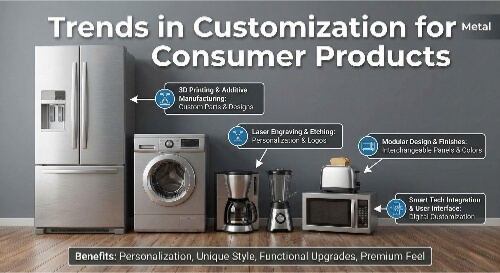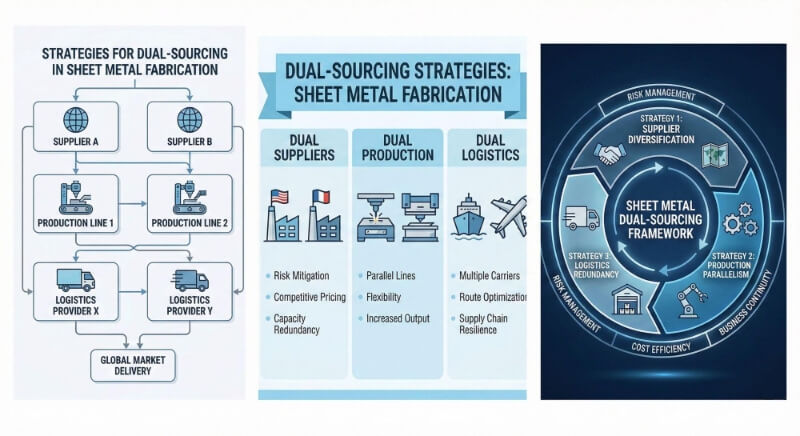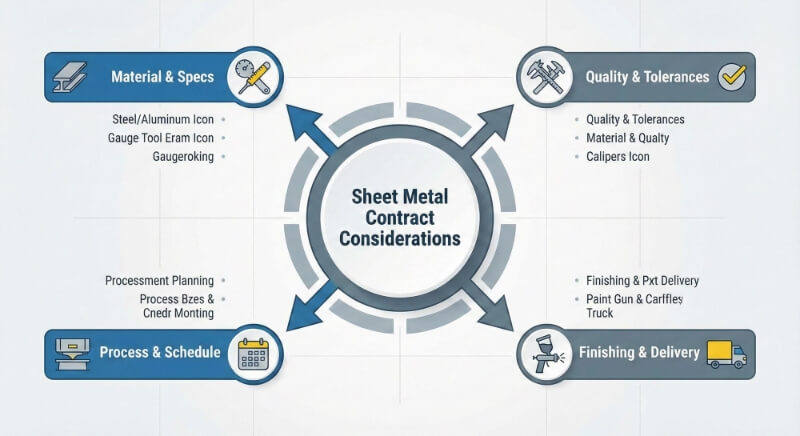Veel fabrikanten en technici hebben nieuwe manieren nodig om onderdelen aan elkaar te bevestigen. Traditionele methoden, zoals lassen en schroeven, kunnen problemen veroorzaken zoals extra gewicht of schade aan materialen. Lijmen verandert de manier waarop mensen verschillende onderdelen verbinden. Het kan deze problemen oplossen door een schonere, snellere en flexibelere methode te bieden.
Lijmen geeft ingenieurs en productmakers nieuwe mogelijkheden. Deze methode kan gewicht besparen, het uiterlijk verbeteren en taaie materialen met elkaar verbinden. Lees verder om te ontdekken hoe lijmverbindingen uw projecten kunnen helpen.
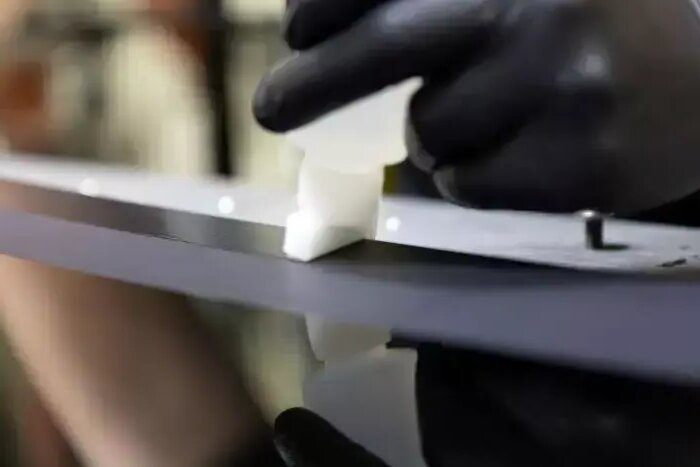
Wat is lijmverbinding?
Lijmen is een verbindingsproces waarbij een materiaal, meestal een vloeistof of pasta, wordt gebruikt om twee oppervlakken aan elkaar te kleven. Het materiaal wordt lijm genoemd. Het verspreidt zich tussen de onderdelen en hardt dan uit om een sterke verbinding te vormen.
Deze methode verandert de vorm van de onderdelen niet. Het werkt goed voor dunne materialen of materialen die niet tegen hitte of druk kunnen. De verbinding verdeelt de spanning gelijkmatig over het oppervlak, wat de sterkte en het uiterlijk kan verbeteren.
De basisprincipes van lijmen
Om te begrijpen waarom lijmen werkt, helpt het om te kijken hoe de lijm aan de oppervlakken kleeft. Er zijn een paar verschillende manieren waarop dit kan gebeuren, afhankelijk van de materialen en de hechtmethode.
Mechanische hechting
Mechanische hechting ontstaat wanneer de lijm in kleine gaatjes of ruwe plekken op het oppervlak vloeit. Wanneer het uithardt, sluit het zich in die kleine ruimtes zoals een sleutel in een slot.
Dit komt vaak voor bij het lijmen van ruwe of poreuze oppervlakken. Hoe beter de lijm de spleten vult, hoe sterker de verbinding. Oppervlaktevoorbereiding, zoals schuren of gritstralen, kan dit effect verbeteren.
Chemische hechting
Chemische hechting ontstaat wanneer de lijm reageert met de oppervlakken. De reactie creëert nieuwe chemische bindingen op het verbindingspunt.
Dit werkt het beste als de lijm en het materiaal chemisch compatibel zijn. Sommige lijmen zijn ontworpen voor specifieke materialen zoals metaal, plastic of glas.
Dit type hechting is zeer sterk. Het wordt vaak gebruikt in structurele verlijmingen waar sterkte het belangrijkst is.
Diffusie Hechting
Diffusiekleefkracht ontstaat wanneer de moleculen in de lijm en het oppervlak in elkaar overgaan. Ze vermengen zich lichtjes op het punt waar ze elkaar raken.
Dit werkt meestal met kunststoffen of vergelijkbare materialen - zowel het oppervlak als de lijm moeten zacht genoeg zijn zodat de moleculen kunnen bewegen.
De verbinding wordt sterker naarmate de materialen zich vermengen. Na verloop van tijd lijkt de verbinding meer op een enkel stuk dan op twee afzonderlijke delen.
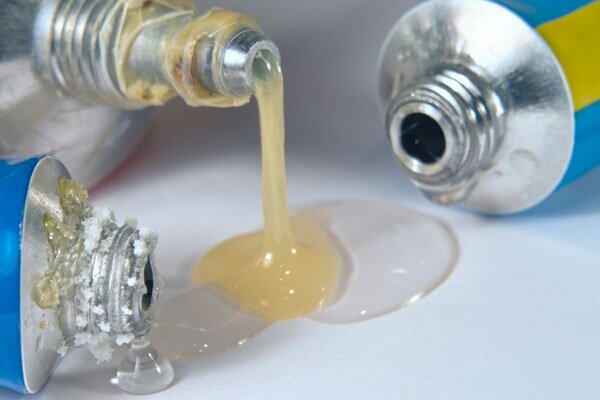
Het lijmproces stap voor stap
Voor een goede hechting moet je elke stap zorgvuldig volgen. Als je er één overslaat, kan de verbinding mislukken. Hier lees je hoe je het goed doet.
Stap 1: Oppervlaktevoorbereiding
Het hechtoppervlak moet schoon en klaar zijn. Stof, olie, roest of vocht kunnen de hechting verzwakken. Begin met reinigen met oplosmiddelen of water en zeep.
Voor een betere grip ruw je het oppervlak op met schurenstralen of een chemische behandeling. Dit helpt de lijm beter te hechten door het oppervlak te vergroten.
Stap 2: Lijmselectie
Kies de juiste lijm voor de klus. Denk na over de materialen die je gaat lijmen, hoe sterk de verbinding moet zijn en de omgeving waarin deze komt, zoals hitte, kou of vocht.
Sommige lijmen werken het beste met plastic, terwijl andere gemaakt zijn voor metaal of glas. Controleer altijd het gegevensblad van het product of doe een kleine test voor volledig gebruik.
Stap 3: Lijm aanbrengen
Breng de lijm gelijkmatig aan op het oppervlak. Je kunt een kwast, roller, knijpfles, spray of dispenser gebruiken, afhankelijk van het type en de benodigde hoeveelheid.
Te veel lijm kan overlopen veroorzaken. Te weinig kan gaten achterlaten. Probeer een dunne, gelijkmatige laag aan te brengen die de lijmlaag goed bedekt.
Stap 4: De oppervlakken met elkaar verbinden
Voeg de twee delen samen terwijl de lijm nog werkbaar is. Lijn ze zorgvuldig uit. Een verkeerde uitlijning kan de sterkte en het uiterlijk van de verbinding beïnvloeden.
Oefen lichte druk uit om de onderdelen op hun plaats te houden. Dit helpt de lijm te verspreiden en ingesloten lucht te verwijderen.
Stap 5: Uitharden
De lijm hardt uit en vormt een verbinding. Dit kan minuten tot uren duren, afhankelijk van het type lijm en de temperatuur.
Sommige lijmen harden uit bij kamertemperatuur. Andere hebben warmte, licht of vocht nodig. Beweeg de onderdelen niet gedurende deze tijd, anders kan de verbinding verzwakken.
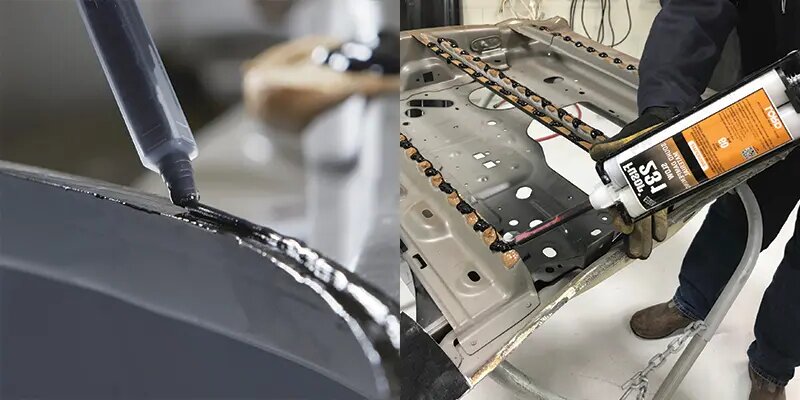
Voordelen van verlijming
Lijmen biedt voordelen die andere verbindingsmethoden niet kunnen evenaren. Het ondersteunt zowel functie als ontwerp, vooral in moderne producten gemaakt van gemengde materialen.
Gelijkmatige spanningsverdeling
Lijmen spreiden de spanning over een groot gebied, niet alleen op een paar punten. Dit helpt zwakke plekken te verminderen en voorkomt scheurvorming. De belasting wordt gelijkmatiger verdeeld, wat de sterkte en duurzaamheid op lange termijn kan verbeteren.
Verbinden van lichtgewicht materialen
Veel lijmen zijn veel lichter dan bouten, schroeven of lassen. Dit is handig in industrieën zoals de auto- of luchtvaartindustrie, waar gewichtsbesparing belangrijk is. Met lijmen kun je ook dunne materialen verbinden zonder extra gewicht toe te voegen of gaten te boren.
Ontwerpflexibiliteit en esthetiek
Lijmen zorgt voor gladdere, schonere ontwerpen. Je hebt geen gaten nodig, bevestigingsmiddelenof lasnaden. Dit helpt om strakke producten te maken zonder zichtbare naden. Het maakt het ook gemakkelijker om gebogen, onregelmatige of moeilijk bereikbare oppervlakken te lijmen.
Beperkingen en uitdagingen
Lijmen biedt veel voordelen, maar is niet perfect. Sommige beperkingen kunnen van invloed zijn op de vraag of dit de juiste methode is voor jouw toepassing.
Draagvermogen
Lijmen kunnen hoge belastingen minder goed aan dan lassen of mechanische bevestigingen. Bij zwaar gebruik kunnen gelijmde verbindingen falen als ze te zwaar worden belast of niet goed worden ondersteund. Voor de veiligheid worden in veel ontwerpen lijmverbindingen gebruikt in combinatie met klinknagels of bouten.
Milieubestendigheid
Sommige lijmen zijn niet goed bestand tegen hitte, kou of vocht. Blootstelling aan zonlicht, chemicaliën of het weer kan de verbinding verbreken. Er worden speciale lijmen gemaakt voor ruwe omgevingen, maar deze kunnen duurder zijn of extra stappen vereisen tijdens het hechten.
Duurzaamheid en veroudering op lange termijn
Na verloop van tijd kunnen lijmen uitdrogen, krimpen of hun sterkte verliezen. Warmte en UV-licht versnellen dit. Gelijmde onderdelen die langdurig worden gebruikt, moeten regelmatig worden geïnspecteerd. De juiste lijm gebruiken en op de juiste manier uitharden helpt de weerstand tegen veroudering te verbeteren.
Factoren die de hechtsterkte beïnvloeden
Een sterke lijmverbinding hangt af van veel kleine details. Als een onderdeel van het proces niet goed werkt, kan de hechting eerder mislukken dan verwacht.
Oppervlakteruwheid
De textuur van het oppervlak speelt een belangrijke rol. Een licht ruw oppervlak helpt de lijm beter te hechten. Als het te glad is, plakt de lijm misschien niet goed. Te ruw en de lijm smeert niet gelijkmatig uit. Licht schuren of stralen geeft vaak de beste resultaten.
Toepassingsmethode
Het maakt uit hoe je de lijm aanbrengt. Een ongelijkmatige laag, ingesloten lucht of te veel lijm kunnen de hechting verzwakken. Het juiste gereedschap gebruiken, zoals een kwast, spuitmond of roller, helpt om de laag glad en consistent te houden.
Milieuomstandigheden
Temperatuur en vochtigheid hebben invloed op hoe de lijm uithardt. Als het te koud of te nat is, kan de uitharding vertragen of helemaal stoppen. Volg altijd de aanbevolen werkomstandigheden van de lijm. Sla materialen op de juiste manier op om problemen te voorkomen voordat de lijm begint uit te harden.
Materiaal compatibiliteit
Niet elke lijm hecht op elk materiaal. Sommige kunststoffen, rubbers of metalen hebben speciale oppervlaktebehandelingen of primers nodig. Controleer de technische gegevens van de lijm om er zeker van te zijn dat deze geschikt is voor jouw materialen. Een snelle test kan later tijd en geld besparen.
Lijmverbinding vergelijken met andere verbindingsmethoden
Hier is een snelle vergelijking van lijmen met lassen en mechanische bevestigingen:
| Functie | Lijmverbinding | Lassen | Mechanische bevestigingsmiddelen |
|---|---|---|---|
| Benodigde warmte | Geen | Ja | Geen |
| Gewichtsimpact | Laag (lichtgewicht) | Matig tot hoog | Voegt extra gewicht toe |
| Oppervlakteschade | Geen | Ja (smelt of verbrandt materiaal) | Ja (gaten of vervorming) |
| Uiterlijk | Schone, gladde afwerking | Zichtbare naden | Zichtbare koppen of schroeven |
| Spanningsverdeling | Zelfs in gebonden gebied | Geconcentreerd bij lasnaden | Geconcentreerd op bevestigingspunten |
| Materiaal compatibiliteit | Lijmt gemakkelijk ongelijke materialen | Vaak beperkt tot vergelijkbare metalen | Werkt met de meeste materialen |
| Uitrusting Kosten | Laag tot matig | Hoog (speciaal gereedschap, training) | Laag tot matig |
| Herbewerking of demontage | Moeilijk schoon te demonteren | Zeer moeilijk | Gemakkelijk uit elkaar te halen |
| Snelheid van toepassing | Matig (heeft uithardingstijd nodig) | Snel voor ervaren operators | Snel en gemakkelijk |
| Beste gebruikscasus | Dunne, gemengde of delicate materialen | Verbindingen van metaal met hoge sterkte | Verwijderbare of verstelbare onderdelen |
Industriespecifieke gebruikssituaties
Lijmen wordt veel gebruikt in verschillende industrieën. Het helpt bij het voldoen aan verschillende behoeften, van sterkte en gewichtsbesparing tot uiterlijk en veiligheid.
Auto- en ruimtevaartindustrie
In auto's en vliegtuigen helpen lijmen om gewicht te besparen zonder aan sterkte in te boeten. Lichtere onderdelen verbeteren de brandstofefficiëntie. Lijmen verbinden ook ongelijke materialen zoals metaal met plastic of koolstofvezel. Ze verminderen geluid en trillingen, wat het comfort en de prestaties verbetert.
Elektronica en consumptiegoederen
Lijmen houden onderdelen in telefoons, tablets en apparaten vast zonder ze omvangrijker te maken. Ze helpen stof en vocht buiten te sluiten. Ze maken ook slanke ontwerpen mogelijk zonder dat er schroeven of clips aan de buitenkant te zien zijn.
Medische hulpmiddelen en verpakking
In medische hulpmiddelen verminderen lijmen de behoefte aan metalen bevestigingsmiddelen, waardoor items lichter en veiliger worden. Voor verpakkingen helpen lijmen voedsel, medicijnen en producten voor persoonlijke verzorging snel en schoon af te sluiten. Ze ondersteunen ook manipulatiebestendige en eenvoudig te openen ontwerpen.
Conclusie
Lijmen is een proces waarbij lijmachtige stoffen worden gebruikt om onderdelen aan elkaar te bevestigen zonder hitte of bevestigingsmiddelen. Het werkt door sterke verbindingen te vormen door grip op het oppervlak, chemische reacties of moleculaire vermenging. Deze methode is schoon, ondersteunt veel materialen en helpt de spanning gelijkmatig over de verbindingen te verdelen.
Hulp nodig bij het kiezen van de juiste hechtmethode voor je project? Stuur ons uw tekeningen of onderdeelgegevens-Wij helpen je een snelle en betrouwbare oplossing te vinden.
Hey, ik ben Kevin Lee

De afgelopen 10 jaar heb ik me verdiept in verschillende vormen van plaatbewerking en ik deel hier de coole inzichten die ik heb opgedaan in verschillende werkplaatsen.
Neem contact op

Kevin Lee
Ik heb meer dan tien jaar professionele ervaring in plaatbewerking, gespecialiseerd in lasersnijden, buigen, lassen en oppervlaktebehandelingstechnieken. Als technisch directeur bij Shengen zet ik me in om complexe productie-uitdagingen op te lossen en innovatie en kwaliteit in elk project te stimuleren.

